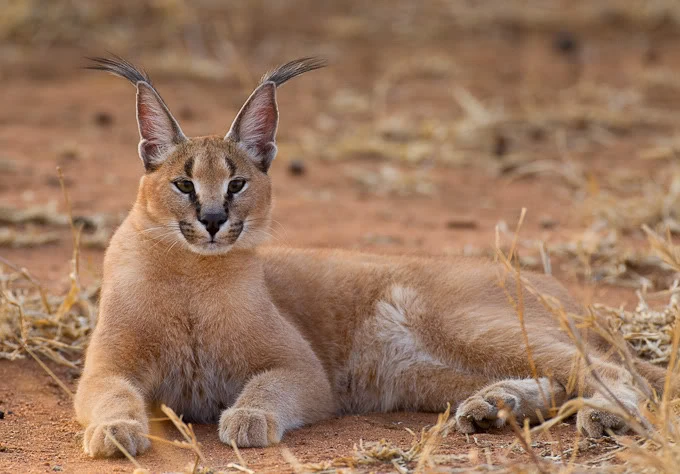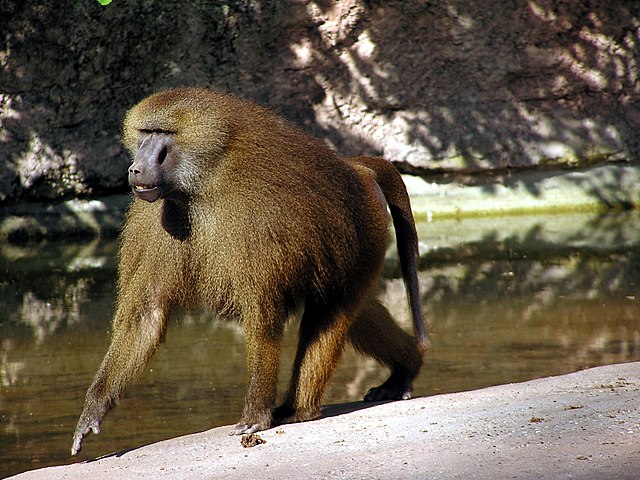Post by dinosauria101 on May 27, 2019 16:48:50 GMT 5
Caracal - Caracal caracal
The caracal (Caracal caracal, pronounced /ˈkærəkæl/) is a fiercely territorial medium-sized cat ranging over Western Asia, South Asia and Africa. The caracal is distributed over Africa, the Middle East, Pakistan and India. Its chief habitat is dry steppes and semideserts, but it also inhabits woodlands, savannah, and scrub forest. They generally prefer open country, so long as there is sufficient cover, in the form of bushes and rocks, from which to ambush prey. The caracal is a slender, yet muscular, cat, with long legs and a short tail. Males typically weigh 13 to 18 kilograms (29 to 40 lb), while females weigh about 11 kilograms (24 lb). The caracal resembles a Eurasian Lynx, and for a long time it was considered a close relative of the lynxes. It has a tail nearly a third of its body length, and both sexes look the same. The caracal is 65 to 90 centimetres (26 to 35 in) in length, with a 30 centimetres (12 in) tail. Compared to lynxes, it has longer legs, shorter fur, and a slimmer appearance.

Guinea Baboon - Papio papio
The Guinea baboon (Papio papio) is a baboon from the Old World monkey family. Some (older) classifications list only two species in the genus Papio, this one and the Hamadryas baboon. In those classifications, all other Papio species are considered subspecies of P. papio and the species is called the savanna baboon. The Guinea baboon inhabits a small area in western Africa. Its range is from Guinea, Senegal, Gambia, southern Mauritania and western Mali. Its habitat includes dry forests, gallery forests, and adjoining bush savannas or steppes. It has reddish brown hair, a hairless, dark-violet or black face with the typical dog-like face, which is surrounded by a small mane, and a tail carried in a round arc. It also has limb modifications that allow it to walk long distances on the ground. The Guinea baboon is the smallest baboon species, weighing between 13 and 26 kg (28.6-57 lbs). Their life span is between 35 and 45 years. It is a diurnal and terrestrial animal, but sleeps in trees at night. The number of suitable sleeping trees limits the group size and the range. It lives in troops of up to 200 individuals, each with a set place in a hierarchy. Group living provides protection from predators such as the Lion and various hyena species. Like all baboons it is omnivorous, eating fruits, buds, roots, grass, greens, seeds, tubers, leaves, nuts, cereals, insects, and small mammals.

Credit to Wikipedia
The caracal (Caracal caracal, pronounced /ˈkærəkæl/) is a fiercely territorial medium-sized cat ranging over Western Asia, South Asia and Africa. The caracal is distributed over Africa, the Middle East, Pakistan and India. Its chief habitat is dry steppes and semideserts, but it also inhabits woodlands, savannah, and scrub forest. They generally prefer open country, so long as there is sufficient cover, in the form of bushes and rocks, from which to ambush prey. The caracal is a slender, yet muscular, cat, with long legs and a short tail. Males typically weigh 13 to 18 kilograms (29 to 40 lb), while females weigh about 11 kilograms (24 lb). The caracal resembles a Eurasian Lynx, and for a long time it was considered a close relative of the lynxes. It has a tail nearly a third of its body length, and both sexes look the same. The caracal is 65 to 90 centimetres (26 to 35 in) in length, with a 30 centimetres (12 in) tail. Compared to lynxes, it has longer legs, shorter fur, and a slimmer appearance.

Guinea Baboon - Papio papio
The Guinea baboon (Papio papio) is a baboon from the Old World monkey family. Some (older) classifications list only two species in the genus Papio, this one and the Hamadryas baboon. In those classifications, all other Papio species are considered subspecies of P. papio and the species is called the savanna baboon. The Guinea baboon inhabits a small area in western Africa. Its range is from Guinea, Senegal, Gambia, southern Mauritania and western Mali. Its habitat includes dry forests, gallery forests, and adjoining bush savannas or steppes. It has reddish brown hair, a hairless, dark-violet or black face with the typical dog-like face, which is surrounded by a small mane, and a tail carried in a round arc. It also has limb modifications that allow it to walk long distances on the ground. The Guinea baboon is the smallest baboon species, weighing between 13 and 26 kg (28.6-57 lbs). Their life span is between 35 and 45 years. It is a diurnal and terrestrial animal, but sleeps in trees at night. The number of suitable sleeping trees limits the group size and the range. It lives in troops of up to 200 individuals, each with a set place in a hierarchy. Group living provides protection from predators such as the Lion and various hyena species. Like all baboons it is omnivorous, eating fruits, buds, roots, grass, greens, seeds, tubers, leaves, nuts, cereals, insects, and small mammals.

Credit to Wikipedia



